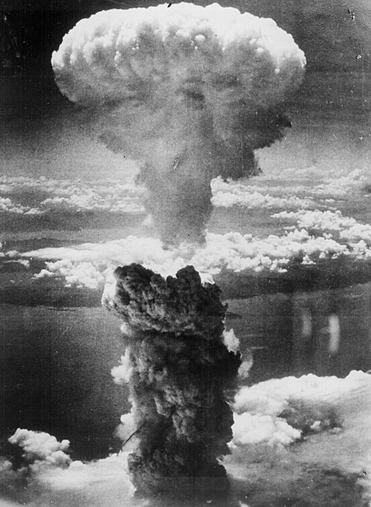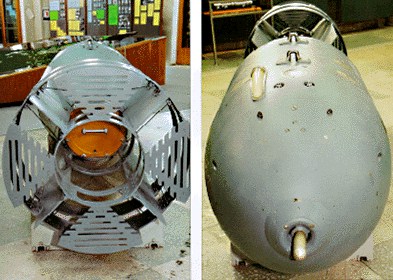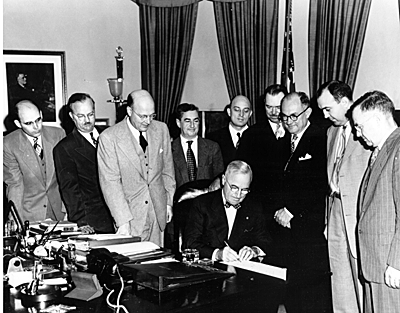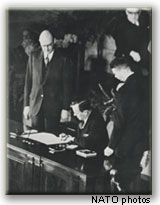Cold War Militarism
Atomic Bomb
 Overshadowing
all these initial cold war issues of 1945 was the atomic bomb. The new weapon
used at
Hiroshima and Nagasaki in early August
presented a whole new category of problems. Even friendly nations would have had
difficulty resolving their problems -- given the state of American and Soviet
affairs in 1945, the situation was positively explosive. The early history of
the bomb is interesting. One would have thought that the Germans, with their V1
and V2 rockets, were far in advance of any developments by the Allies. But
thanks to Hitler and the Nazis, from the early 1930s onward, there was a steady
exodus of Germany's greatest scientific minds. They came to Cambridge in England
or to the United States.
Albert Einstein (1879-1955),
Max Planck (1858-1947),
Werner Heisenberg (1901-1976) had all pioneered
the new physics upon which nuclear fission rested. The Hungarian
Leo Szilard (1898-1964) and Danish scientist
Niels Bohr (1885-1962) had worked on uranium
fission in Germany before the war, but they left as well. In August 1939,
Einstein wrote a
letter to FDR urging him of the necessity to
start work on a new super-weapon before the Germans had developed one
themselves.
Overshadowing
all these initial cold war issues of 1945 was the atomic bomb. The new weapon
used at
Hiroshima and Nagasaki in early August
presented a whole new category of problems. Even friendly nations would have had
difficulty resolving their problems -- given the state of American and Soviet
affairs in 1945, the situation was positively explosive. The early history of
the bomb is interesting. One would have thought that the Germans, with their V1
and V2 rockets, were far in advance of any developments by the Allies. But
thanks to Hitler and the Nazis, from the early 1930s onward, there was a steady
exodus of Germany's greatest scientific minds. They came to Cambridge in England
or to the United States.
Albert Einstein (1879-1955),
Max Planck (1858-1947),
Werner Heisenberg (1901-1976) had all pioneered
the new physics upon which nuclear fission rested. The Hungarian
Leo Szilard (1898-1964) and Danish scientist
Niels Bohr (1885-1962) had worked on uranium
fission in Germany before the war, but they left as well. In August 1939,
Einstein wrote a
letter to FDR urging him of the necessity to
start work on a new super-weapon before the Germans had developed one
themselves.
The Cavendish
Laboratory at Cambridge became the most important British research center. It
was at Cavendish that
Ernest Rutherford (1871-1937) first achieved
atomic disintegration in 1919 and where
James Chadwick (1891-1974) identified the
neutron in 1932. The first chain reaction uranium fission was achieved at the
University of Chicago in 1942. A huge nuclear plant built at Oak Ridge,
Tennessee, produced fissionable material in large quantities. Under the
direction of
J. Robert Oppenheimer (1904-1967)), the actual
weapons development took place at
Los Alamos in New Mexico.

During World War Two,
Roosevelt and Churchill followed a policy that would ensure a nuclear arms race
at war's end. Still, Stalin found out about the
Manhattan Project and by 1943 had already begun
development of a Soviet bomb. After the destruction of Hiroshima and Nagaski and
the subsequent surrender of Japan, the United States developed a disarmament
plan based on turning over all fissionable materials, plants and bombs to an
international regulatory agency. The Soviets responded quickly with their own
plan which stipulated nothing less than a total ban on the production of all
fissionable material. They further added that all existing bombs would be
destroyed. Wishing to preserve its monopoly on nuclear weapons, the United
States continued to stress regulation and inspection by an independent agency.
But the Soviets, in the hopes of neutralizing any United States advantage,
insisted on immediate disarmament. No agreement could be made.
Containment Policy
 Another
cause of the cold war revolved around a relatively new development in United
States-Soviet relations. At the beginning of 1946, Truman decided that he was
"tired of babysitting the Soviets who understand only an iron fist and strong
language." Stalin responded in February with a speech stressing the basic
incompatibility between Soviet communism and western democracy, thus
inaugurating a new hard line policy. Frustrated, Washington found meaning in a
crucial document known as the "Long
Telegram." In 1946, the Soviet expert
George Kennan, sent an 8000 word telegram to
Washington from Moscow. Kennan was a foreign service officer who new Russia
well. He understood their history, their culture and their language. Kennan
explained the communist mentality in the following way. The Soviet's hostility
to the west is rooted in the need to legitimize their bloody dictatorship --
they must therefore believe in the inevitable triumph of communism over the
beast capitalism. The Soviets, Kennan continued, would exploit every opportunity
to extend their system and therefore could not and would not be converted to a
policy of harmony and cooperation. According to Kennan, Russia's policy was:
Another
cause of the cold war revolved around a relatively new development in United
States-Soviet relations. At the beginning of 1946, Truman decided that he was
"tired of babysitting the Soviets who understand only an iron fist and strong
language." Stalin responded in February with a speech stressing the basic
incompatibility between Soviet communism and western democracy, thus
inaugurating a new hard line policy. Frustrated, Washington found meaning in a
crucial document known as the "Long
Telegram." In 1946, the Soviet expert
George Kennan, sent an 8000 word telegram to
Washington from Moscow. Kennan was a foreign service officer who new Russia
well. He understood their history, their culture and their language. Kennan
explained the communist mentality in the following way. The Soviet's hostility
to the west is rooted in the need to legitimize their bloody dictatorship --
they must therefore believe in the inevitable triumph of communism over the
beast capitalism. The Soviets, Kennan continued, would exploit every opportunity
to extend their system and therefore could not and would not be converted to a
policy of harmony and cooperation. According to Kennan, Russia's policy was:
to undermine the
general and strategic potential of major western powers by a host of
subversive measures to destroy individual governments that might stand in the
Soviet path, to do everything possible to set the major Western powers against
each other.
But since the Soviets
believed that communism would triumph through the natural course of history, the
communists were in no hurry and would not risk major war. Met with firmness,
Kennan went on, the Soviets will back off. Kennan's observations quickly
changed Washington's treatment of the Soviet Union. The United States now
embarked on a path of intervention to try to "contain" communism, and to keep it
from "spreading" to the West.
Intervention in
Greece
Most western European
Communist parties were at a peak in the years immediately following World War
Two. The French Communist Party, for instance, won almost 30% of the vote in
November 1946 elections. In Greece, Communist led guerrillas supplied from
Yugoslavia, Bulgaria and Albania, posed a threat to the government of Greece.
The Greek communists attempted to seize power in late 1944, when their tactics
of mass slaughter horrified a majority of Greeks.
Civil war eventually
broke out in Greece in 1946 amid economic crisis. By January 1947, the British
informed the United States that they could no longer supply economic aid to
Greece or Turkey. Believing that the Soviet Union was responsible for Britain's
pullout, the United States decided that they had to assume the role of supplying
aid. The
Truman Doctrine announced aid to Greece and
Turkey to fund a general war against communism. Aid in the amount of $400
million was approved by the House and Senate by a margin of three to one. In
many ways, the Truman Doctrine marked the formal declaration of the cold war
between the United States and the Soviet Union.
The Soviets accepted
the Truman Doctrine's "two rival worlds" idea. It went along with the
Marxist-Leninist notion of a world divided into two hostile camps -- one
capitalist, the other communist. For Stalin, a final class struggle, determined
by the laws of historical development, would mean certain Soviet victory.
U.S. Aid to Germany
and Japan
 In
May came the American decision to rebuild Germany and Japan from the disaster
left from WWII. On June 5, Secretary of State George C. Marshall gave a speech
at Harvard which would further harden the United States' position toward the
Soviets. Marshall proposed a scheme of extensive aid to all European nations if
they could agree on building a free market economy. Marshall even included the
Soviets in his plan. But at a meeting in Paris the following month, the Soviets
gave their response to the Marshall Plan by walking out. Neither Russia nor its
satellite states would take up the offer. Meanwhile, as the Marshall Plan pumped
US dollars into Europe, West German economic recovery began to trigger a general
European recovery. The Soviets viewed this development as little more than a
capitalist plot to draw the nations of eastern European into the American sphere
of influence.
In
May came the American decision to rebuild Germany and Japan from the disaster
left from WWII. On June 5, Secretary of State George C. Marshall gave a speech
at Harvard which would further harden the United States' position toward the
Soviets. Marshall proposed a scheme of extensive aid to all European nations if
they could agree on building a free market economy. Marshall even included the
Soviets in his plan. But at a meeting in Paris the following month, the Soviets
gave their response to the Marshall Plan by walking out. Neither Russia nor its
satellite states would take up the offer. Meanwhile, as the Marshall Plan pumped
US dollars into Europe, West German economic recovery began to trigger a general
European recovery. The Soviets viewed this development as little more than a
capitalist plot to draw the nations of eastern European into the American sphere
of influence.
1947 was a crucial year
in early cold war history. The forces of the free world, it seemed, were
rallying to resist Soviet aggression, build up the defenses of the non-communist
world and, tackle the problem of European economic recovery with massive
assistance from the United States.
NATO
 The
issue of Soviet containment was also played out in 1949 with the creation of the
North Atlantic Treaty Organization or NATO. The
idea for something like NATO grew from general European fears of renewed Soviet
aggression. Hitler was still on everybody's mind. Although Hitler was dead, was
Stalin perhaps viewed as the next aggressor? Western Europe also needed
some guarantee from the United States that they would be protected from any
aggression while they began the slow process of economic recovery.
The
issue of Soviet containment was also played out in 1949 with the creation of the
North Atlantic Treaty Organization or NATO. The
idea for something like NATO grew from general European fears of renewed Soviet
aggression. Hitler was still on everybody's mind. Although Hitler was dead, was
Stalin perhaps viewed as the next aggressor? Western Europe also needed
some guarantee from the United States that they would be protected from any
aggression while they began the slow process of economic recovery.
The North Atlantic
Treaty was eventually signed April 4, 1949. NATO was created with the sole aim
of protecting Europe from Soviet aggression, "to safeguard the freedom, common
heritage and civilization of their peoples founded on the principles of
democracy, individual liberty, and the rule of law." There were two main
features of the Treaty. First, the United States made a firm commitment to
protect and defend Europe. As stated in the Treaty, "an armed attack against one
shall be considered an attack against all." Second, the United States would
indeed honor its commitment to defend Europe. So in 1950, Truman selected
Dwight D. Eisenhower as the Supreme Commander
of NATO forces. Four United States divisions were stationed in Europe to serve
as the nucleus of NATO forces.
The American public
embraced NATO because it offered a way of participating in world affairs and
opposing Soviet power in a more indirect way. Americans no longer believed that
world security would come through the United Nations -- itself a product of
World War One -- but they still held on to the ideas of some sort of collective
security with an ideological base. The Atlantic nations were said to be held
together by both common interests as well as a common commitment to democracy
and industrial capitalism. For western Europe, NATO provided a much-needed
shelter of security behind which economic recovery could take place. For the
United States, NATO signified that the United States could no longer remain
isolated from European affairs. Indeed, NATO meant that European affairs were
now American affairs as well.
The western alliance
embodied in NATO had the effect of escalating the cold war. NATO was created by
a reaction of the western world to what they perceived to be Soviet aggression.
In the end there was very little evidence of a Soviet plot to invade western
Europe. NATO intensified Soviets fears of the West and produced even higher
levels of international tension.
Arms Race
 As
the rivalry between the United States and the Soviet Union grew in the late
1940s and into the 50s, both countries began to rebuild their military forces.
In 1947, Congress solved both issues by creating the National Security Act. The
results of this Act should be familiar to all of us today since it established
institutions we know take for granted. The Act created first, a Department of
Defense which would serve as an organizing principle over the army, navy and air
force. Second, the Act created the
National Security Council, a special advisory
board to the executive office. And lastly, the Act created the Central
Intelligence Agency or CIA, which was in charge of all intelligence.
As
the rivalry between the United States and the Soviet Union grew in the late
1940s and into the 50s, both countries began to rebuild their military forces.
In 1947, Congress solved both issues by creating the National Security Act. The
results of this Act should be familiar to all of us today since it established
institutions we know take for granted. The Act created first, a Department of
Defense which would serve as an organizing principle over the army, navy and air
force. Second, the Act created the
National Security Council, a special advisory
board to the executive office. And lastly, the Act created the Central
Intelligence Agency or CIA, which was in charge of all intelligence.
In 1949, American
military planners received a rather profound shock: the Soviets had just
succeeded in exploding an atomic bomb of their own. The first United
States explosion of an H-bomb, or hydrogen bomb, took place in 1952. The Soviets
announced the detonation of a similar thermonuclear device in August of the
following year. This fusion bomb is many times more powerful than the A-bomb. In
fact, since it operates by chain reaction, the only limit to its size is
determined by the size of the aircraft which is carrying it. A bomber can carry
a 100 megaton bomb. The Hiroshima bomb, which killed 80,000 souls in less than
fifteen minutes, was about 1/700th as large as a 100 megaton bomb. Because the
H-bomb was manufactured from one of the most common elements, enough bombs could
be readily produced to destroy the planet several times.
Of course, who would
want to do that? This was possibly the most dangerous period for nuclear war.
The vast growth in the numbers and kinds of long range nuclear weapons meant the
neither the United States nor the Soviet Union could hope to escape the ravages
of thermonuclear war. Of course, the massive numbers of nuclear warheads
produced actually resulted in a stalemate -- and this was good for everyone
concerned. The world shuddered at the thought that the destiny of the globe was
in the hands of two super powers, creating the "balance of terror".
In the wake of all
these developments a new national defense policy was needed by the United States
and it came with a policy document known as
NSC-68. NSC-68 was based on the premise that
first, the Soviets were trying to impose absolute authority over the world and
second, that the United States had to face that challenge. What all this boiled
down to was this: no more appeasement and no more isolation. Instead, upwards of
50% of the Gross National Product of the United States was now directed to
defense spending. NSC-68 proposed increasing the defense budget from $13 to $45
billion annually. Approved April, 1950, NSC-68 stands as a symbol of America's
determination to win the cold war regardless of cost.
 Overshadowing
all these initial cold war issues of 1945 was the atomic bomb. The new weapon
used at
Hiroshima and Nagasaki in early August
presented a whole new category of problems. Even friendly nations would have had
difficulty resolving their problems -- given the state of American and Soviet
affairs in 1945, the situation was positively explosive. The early history of
the bomb is interesting. One would have thought that the Germans, with their V1
and V2 rockets, were far in advance of any developments by the Allies. But
thanks to Hitler and the Nazis, from the early 1930s onward, there was a steady
exodus of Germany's greatest scientific minds. They came to Cambridge in England
or to the United States.
Albert Einstein (1879-1955),
Max Planck (1858-1947),
Werner Heisenberg (1901-1976) had all pioneered
the new physics upon which nuclear fission rested. The Hungarian
Leo Szilard (1898-1964) and Danish scientist
Niels Bohr (1885-1962) had worked on uranium
fission in Germany before the war, but they left as well. In August 1939,
Einstein wrote a
letter to FDR urging him of the necessity to
start work on a new super-weapon before the Germans had developed one
themselves.
Overshadowing
all these initial cold war issues of 1945 was the atomic bomb. The new weapon
used at
Hiroshima and Nagasaki in early August
presented a whole new category of problems. Even friendly nations would have had
difficulty resolving their problems -- given the state of American and Soviet
affairs in 1945, the situation was positively explosive. The early history of
the bomb is interesting. One would have thought that the Germans, with their V1
and V2 rockets, were far in advance of any developments by the Allies. But
thanks to Hitler and the Nazis, from the early 1930s onward, there was a steady
exodus of Germany's greatest scientific minds. They came to Cambridge in England
or to the United States.
Albert Einstein (1879-1955),
Max Planck (1858-1947),
Werner Heisenberg (1901-1976) had all pioneered
the new physics upon which nuclear fission rested. The Hungarian
Leo Szilard (1898-1964) and Danish scientist
Niels Bohr (1885-1962) had worked on uranium
fission in Germany before the war, but they left as well. In August 1939,
Einstein wrote a
letter to FDR urging him of the necessity to
start work on a new super-weapon before the Germans had developed one
themselves. 
 Another
cause of the cold war revolved around a relatively new development in United
States-Soviet relations. At the beginning of 1946, Truman decided that he was
"tired of babysitting the Soviets who understand only an iron fist and strong
language." Stalin responded in February with a speech stressing the basic
incompatibility between Soviet communism and western democracy, thus
inaugurating a new hard line policy. Frustrated, Washington found meaning in a
crucial document known as the "
Another
cause of the cold war revolved around a relatively new development in United
States-Soviet relations. At the beginning of 1946, Truman decided that he was
"tired of babysitting the Soviets who understand only an iron fist and strong
language." Stalin responded in February with a speech stressing the basic
incompatibility between Soviet communism and western democracy, thus
inaugurating a new hard line policy. Frustrated, Washington found meaning in a
crucial document known as the " In
May came the American decision to rebuild Germany and Japan from the disaster
left from WWII. On June 5, Secretary of State George C. Marshall gave a speech
at Harvard which would further harden the United States' position toward the
Soviets. Marshall proposed a scheme of extensive aid to all European nations if
they could agree on building a free market economy. Marshall even included the
Soviets in his plan. But at a meeting in Paris the following month, the Soviets
gave their response to the Marshall Plan by walking out. Neither Russia nor its
satellite states would take up the offer. Meanwhile, as the Marshall Plan pumped
US dollars into Europe, West German economic recovery began to trigger a general
European recovery. The Soviets viewed this development as little more than a
capitalist plot to draw the nations of eastern European into the American sphere
of influence.
In
May came the American decision to rebuild Germany and Japan from the disaster
left from WWII. On June 5, Secretary of State George C. Marshall gave a speech
at Harvard which would further harden the United States' position toward the
Soviets. Marshall proposed a scheme of extensive aid to all European nations if
they could agree on building a free market economy. Marshall even included the
Soviets in his plan. But at a meeting in Paris the following month, the Soviets
gave their response to the Marshall Plan by walking out. Neither Russia nor its
satellite states would take up the offer. Meanwhile, as the Marshall Plan pumped
US dollars into Europe, West German economic recovery began to trigger a general
European recovery. The Soviets viewed this development as little more than a
capitalist plot to draw the nations of eastern European into the American sphere
of influence.  The
issue of Soviet containment was also played out in 1949 with the creation of the
The
issue of Soviet containment was also played out in 1949 with the creation of the
 As
the rivalry between the United States and the Soviet Union grew in the late
1940s and into the 50s, both countries began to rebuild their military forces.
In 1947, Congress solved both issues by creating the National Security Act. The
results of this Act should be familiar to all of us today since it established
institutions we know take for granted. The Act created first, a Department of
Defense which would serve as an organizing principle over the army, navy and air
force. Second, the Act created the
As
the rivalry between the United States and the Soviet Union grew in the late
1940s and into the 50s, both countries began to rebuild their military forces.
In 1947, Congress solved both issues by creating the National Security Act. The
results of this Act should be familiar to all of us today since it established
institutions we know take for granted. The Act created first, a Department of
Defense which would serve as an organizing principle over the army, navy and air
force. Second, the Act created the